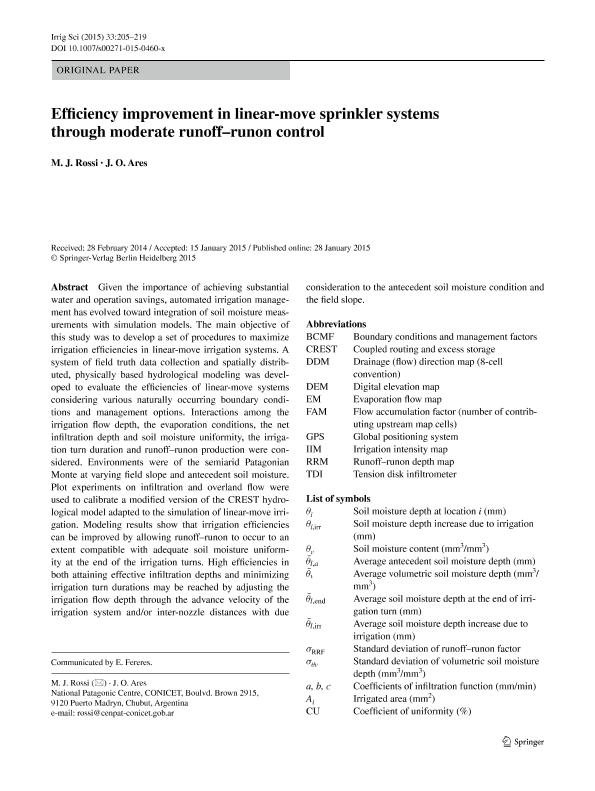Mostrar el registro sencillo del ítem
dc.contributor.author
Rossi, María Julieta

dc.contributor.author
Ares, Jorge Oscar

dc.date.available
2017-07-27T17:39:54Z
dc.date.issued
2015-01-28
dc.identifier.citation
Rossi, María Julieta; Ares, Jorge Oscar; Efficiency improvement in linear‑move sprinkler systems through moderate runoff–runon control; Springer Verlag Berlín; Irrigation Science; 33; 3; 28-1-2015; 205-219
dc.identifier.issn
0342-7188
dc.identifier.uri
http://hdl.handle.net/11336/21466
dc.description.abstract
Given the importance of achieving substantial water and operation savings, automated irrigation management has evolved toward integration of soil moisture measurements with simulation models. The main objective of this study was to develop a set of procedures to maximize irrigation efficiencies in linear-move irrigation systems. A system of field truth data collection and spatially distributed, physically based hydrological modeling was developed to evaluate the efficiencies of linear-move systems considering various naturally occurring boundary conditions and management options. Interactions among the irrigation flow depth, the evaporation conditions, the net infiltration depth and soil moisture uniformity, the irrigation turn duration and runoff–runon production were considered. Environments were of the semiarid Patagonian Monte at varying field slope and antecedent soil moisture. Plot experiments on infiltration and overland flow were used to calibrate a modified version of the CREST hydrological model adapted to the simulation of linear-move irrigation. Modeling results show that irrigation efficiencies can be improved by allowing runoff–runon to occur to an extent compatible with adequate soil moisture uniformity at the end of the irrigation turns. High efficiencies in both attaining effective infiltration depths and minimizing irrigation turn durations may be reached by adjusting the irrigation flow depth through the advance velocity of the irrigation system and/or inter-nozzle distances with due consideration to the antecedent soil moisture condition and the field slope.
dc.format
application/pdf
dc.language.iso
eng
dc.publisher
Springer Verlag Berlín

dc.rights
info:eu-repo/semantics/openAccess
dc.rights.uri
https://creativecommons.org/licenses/by-nc-sa/2.5/ar/
dc.subject
Irrigation Efficiency
dc.subject
Automated Irrigation
dc.subject
Semiarid Irrigation
dc.subject.classification
Otras Ingeniería del Medio Ambiente

dc.subject.classification
Ingeniería del Medio Ambiente

dc.subject.classification
INGENIERÍAS Y TECNOLOGÍAS

dc.title
Efficiency improvement in linear‑move sprinkler systems through moderate runoff–runon control
dc.type
info:eu-repo/semantics/article
dc.type
info:ar-repo/semantics/artículo
dc.type
info:eu-repo/semantics/publishedVersion
dc.date.updated
2017-07-27T12:33:36Z
dc.identifier.eissn
1432-1319
dc.journal.volume
33
dc.journal.number
3
dc.journal.pagination
205-219
dc.journal.pais
Alemania

dc.journal.ciudad
Berlin
dc.description.fil
Fil: Rossi, María Julieta. Consejo Nacional de Investigaciones Científicas y Técnicas. Centro Nacional Patagónico; Argentina
dc.description.fil
Fil: Ares, Jorge Oscar. Consejo Nacional de Investigaciones Científicas y Técnicas. Centro Nacional Patagónico; Argentina
dc.journal.title
Irrigation Science

dc.relation.alternativeid
info:eu-repo/semantics/altIdentifier/doi/http://dx.doi.org/10.1007/s00271-015-0460-x
dc.relation.alternativeid
info:eu-repo/semantics/altIdentifier/url/https://link.springer.com/article/10.1007%2Fs00271-015-0460-x
Archivos asociados
